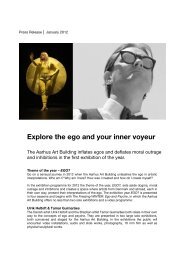eller - Århus Kunstbygning
eller - Århus Kunstbygning
eller - Århus Kunstbygning
You also want an ePaper? Increase the reach of your titles
YUMPU automatically turns print PDFs into web optimized ePapers that Google loves.
36<br />
Dawood over a decade, use photographs and charge a set price, like any shop or craft in the<br />
street. The wildlife paintings of The Great Outdoors I, II & III, (Oil on Canvas 2008), ‘fit’ the<br />
scenarios of the Western perhaps, by romanticising landscape, to stretch the horizon to point<br />
toward shamanist ritual, and the sacral, in depictions of animals, but are fabricated by workers<br />
with whom he builds specific and sophisticated long-term relations.<br />
A cat appears in a new work, The Hidden City, (Slide projection and video loop, 2010). This<br />
work was conceived during a visit to Moscow. A notion of contamination, in the Eastern Bloc<br />
of the 1960s generated by the Cold War, is allegorised, linking ZIL, the Soviet-era car plant in<br />
Moscow with 11th Century Medina in Marrakech. A cat moves as ‘go-between’ in time. Spe-<br />
cifically, this is Behemoth, the black cat from Mikhail Bulgakov’s complex novel The Master &<br />
Margarita, published in 1966-67 twenty-six years after the author’s death.<br />
A video shows the ‘Solaris’ cafe in downtown Marrakech, connoting the alien zone of<br />
consciousness in Solaris, the science fiction novel, originally written by the Polish author Stan-<br />
islaw Lem, in 1961, and made into a film by Andrei Tarkovsky. As a collective allegorical work,<br />
it elaborates a similar concept to William Burroughs’ Interzone - a kind of liminal free port,<br />
where different cultures and histories interweave to ‘cut-up’ between objective experience and<br />
subjective consciousness. The novel by Stanisław Lem concerns the ultimate inadequacy of<br />
communication between human and non-human species. In Dawood’s reconfigured scenario,<br />
these polarities are dispensed with references to the hallucinatory effects of literature that void<br />
a subject’s sense of terrestrial geographies. The affective zone produced directs violence to<br />
symbolic language, to navigate transgression, and occultism, within a critique of both socie-<br />
ties.<br />
In The Wasteland, 2008, thirty-three ram skulls are marked with Om symbols after the famous<br />
‘Purple Om’ acid tabs, distributed in London during the ‘Summer of Love’ in 1989. The strength<br />
of the trip caused widespread psychosis. Dawood alerts attention to initiation’s power to col-<br />
lapse meaning. It remains highly ambiguous what these skulls ‘mean’, but they mark out a field<br />
of desire, collected together as if a shrine for an unknown purpose or ritual.<br />
The Wasteland is the title of T.S. Eliot’s 1922 poem cycle, whose infamous opening verse<br />
speaks of “The Burial of the Dead”:<br />
April is the cruellest month, breeding<br />
Lilacs out of the dead land, mixing<br />
Memory and desire, stirring<br />
Dull roots with spring rain<br />
Dawood adjusts Eliot’s conceit by suggesting that the acid, Purple Om, might break the re-<br />
petitive cycle of birth and death by the ingesting of a chemical into the body - a revival of the<br />
liberation movements of the 1960s. Shamanism / psychosis is offered as an escape route from<br />
eternal re-runs. A one-way ticket.<br />
The Wasteland, ram skulls and acrylic paint, installation view, 2008<br />
Another project tested the elevation of skill as an ideal in painting by determining a set time<br />
period to complete a series of scenic images, like a war artist on the battlefield, before photog-<br />
raphy, where skill in drawing has been a necessity. Dawood worked from a memory of the film<br />
Battle of Algiers 1 , thereby confuting ideas of the photographic and the drawn in one process,<br />
which seek a plane of temporal reference between the two processes. This differs also in the<br />
notion of post-photographic practice where the real is completely erased.<br />
The Battle of Algiers reconstructs events that occurred in the capital city of French Algeria<br />
between November 1954 and December 1960, during the Algerian War of Independence. The<br />
narrative begins with the organization of revolutionary cells in the Casbah. Then civil war be-<br />
tween native Algerians and European settlers (‘pied-noirs’) in which the sides exchange acts of<br />
increasing violence, lead to the introduction of French army paratroopers to hunt the National<br />
37



